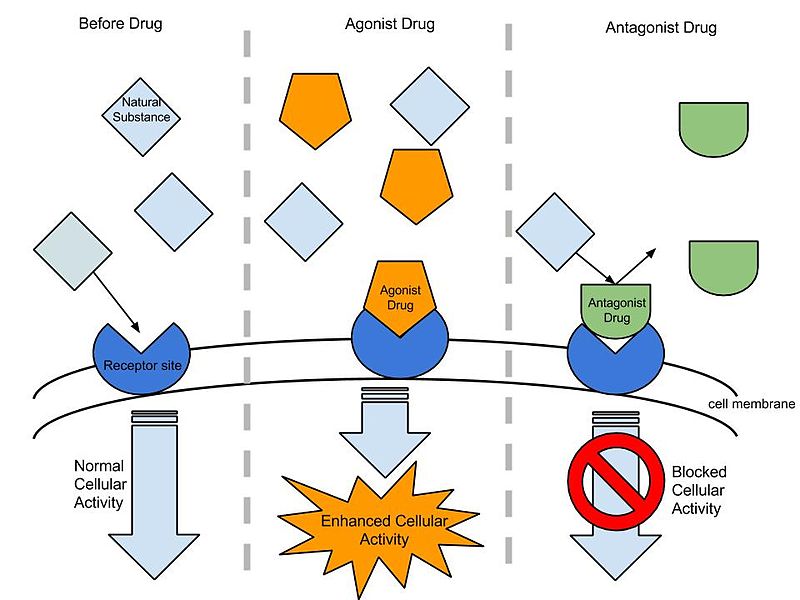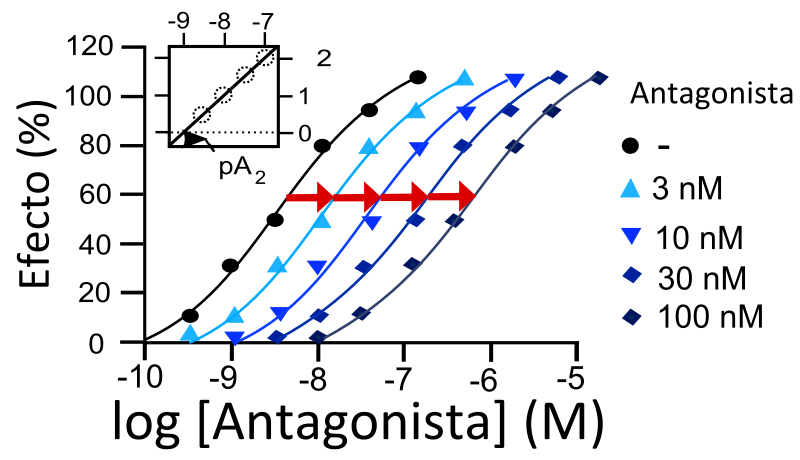Difference Between Agonist and Antagonist Drugs
Key Difference – Agonist vs Antagonist Drugs
Opioids are drugs which include both illegal drugs and prescribed drugs. Opioids act as pain relievers but possess many unhealthy side effects if taken in overdoses. The mechanism of opioids can be explained by two mechanisms – the agonistic mechanism and the antagonistic mechanism. Thus, drugs can be mainly divided into Agonist drugs and Antagonist drugs. Agonist drugs are drugs which are capable of activating receptors in the brain upon binding to the receptor resulting in the full effect of the opioids. Antagonist drugs bind to the receptors in the brain and block the binding of opioids to the receptors thereby inhibiting the effect of the opioid. The key difference between agonists and antagonists is their counteractive mechanism. Agonists produce actions whereas antagonists inhibit the actions.
CONTENTS
1. Overview and Key Difference
2. What are Agonist Drugs
3. What are Antagonist Drugs
4. Similarities Between Agonist and Antagonist Drugs
5. Side by Side Comparison – Agonist vs Antagonist Drugs in Tabular Form
6. Summary
What are Agonist Drugs?
An agonist drug is a chemical that mimics the natural ligand of the specific brain receptor. Thus the binding of the agonist drug results in similar biological effect as the natural ligand. The agonist binds to the same binding site as that of the natural ligand. Thus, in the absence of the natural ligand, agonist drugs are capable of providing the full or the partial response. Examples of agonist drugs include heroin, oxycodone, methadone, hydrocodone, morphine, and opium. Some of which like heroin are declared as illegal. These drugs bring relief of pain. Strong doses can have many side effects related to respiration, organ failure, drowsiness, and numbness.

Figure 01: Mechanism of Agonist and Antagonist drugs
Types of Agonist Drugs
There are two main types of agonist drugs;
- Direct binding agonist drugs
- Indirect binding agonist drugs
Direct binding agonist drugs or complete agonists are capable of directly binding to the specific binding site of the receptor. This binding site is the site in which the natural ligand binds under normal conditions. This brings about a faster response as it directly binds to the receptor and activates the brain signaling. Examples are morphine and nicotine.
Indirect binding agonist drugs are also termed as partial agonists, are drugs which enhance the binding of the natural ligand to the receptor to bring about an effect. These drugs give delayed responses. An example of an indirect binding agonist is cocaine.
What are Antagonist Drugs?
Antagonist drugs are drugs which inhibit the effects of the natural ligand. The natural ligand can be a hormone, neurotransmitter or an agonist.
Types of Antagonist Drugs
Antagonist drugs can be of three main types.
- Competitive antagonists
- Non – competitive antagonists
- Irreversible antagonists

Figure 02: Mechanism of Antagonist drugs
Competitive antagonist drugs are drugs which have the ability to bind at the original binding site and inhibit the binding of the natural ligand. This is due to the shape of the antagonist which mimics the natural ligand. Increasing the ligand concentration can suppress the effect of the competitive antagonist.
Noncompetitive antagonist drugs act allosterically, where it binds to another site other than the true binding site. The binding of the non – competitive antagonist will cause a conformational change in the receptor which will inhibit the binding of the true ligand.
Irreversible agonist drugs bind strongly to the receptor through covalent linkages. This will permanently modify the receptor preventing the binding of the ligand. Examples of antagonist drugs include naltrexone and naloxone. Most often these drugs are used to inhibit the effects of harmful drugs such as cocaine and heroin which are agonist drugs.
What are the Similarities Between Agonist and Antagonist Drugs?
- Both are chemical drugs which can bind to receptors in the brain.
- Both function in a counteractive manner.
- Both can be mainly of two types – illegal drugs or medically prescribed drugs.
- Both are specific towards the receptors.
- Both are referred to as pain relievers.
- Both can cause harmful health manifestations if taken in overdose.
What is the Difference Between Agonist and Antagonist Drugs?
Agonist vs Antagonist Drugs | |
| Agonist drugs are the drugs which are capable of activating receptors in the brain upon binding to the receptor resulting in the full effect of the ligand. | Antagonist drugs are the drugs which bind to the receptors in the brain and block the binding of ligands to the receptors thereby inhibiting the effect of the ligand. |
| Effects | |
| Agonist drugs stimulate the action. | Antagonist drugs inhibit the action. |
| Response | |
| The response is caused when the agonist binds to the binding site. | The response is prevented when the antagonist binds to the binding site. |
| Types | |
| There are two types of agonist drugs; Direct binding agonist drugs and Indirect binding agonist drugs. | There are three types of antagonist drugs; Competitive antagonist drugs, Non – competitive antagonist drugs, and Irreversible antagonist drugs. |
Summary – Agonist vs Antagonist Drugs
Agonist and antagonist drugs work in a counteractive mechanism. Agonist drugs function in enhancing the effectiveness of the natural ligand binding thereby up-regulating the effect of the ligand. In contrast, Antagonist drugs down-regulate the effect of the ligand by binding to the receptor and blocking the receptor from binding to its receptor. This is the key difference between Agonistic drugs and Antagonistic drugs. Both scenarios effect in relieving pain and therefore act as potential painkillers. Some of the drugs such as morphine are prescribed and legal to be used under medical supervision, whereas some are illegal to be used (heroin).
Download the PDF Version of Agonist vs Antagonist Drugs
You can download PDF version of this article and use it for offline purposes as per citation note. Please download PDF version here Difference Between Agonist and Antagonist Drugs
Reference:
1.Libretexts. “C6. Agonist and Antagonist of Ligand Binding to Receptors – An Extension.” Biology LibreTexts, Libretexts, 10 May 2017.
Image Courtesy:
1.’Agonist & Antagonist’By Dolleyj – Own work (CC BY-SA 3.0) via Commons Wikimedia
2.’Agonist Antagonist’By ES:Usuario:House – File:Agonist_Antagonist.png (CC BY-SA 3.0) via Commons Wikimedia
ncG1vNJzZmivp6x7pbXFn5yrnZ6YsqOx07CcnqZemLyue8OinZ%2Bdopq7pLGMm5ytr5Wau26txqiloqukYq6vsIyvqmaZnqmuqLvNoqqtZZSnwqi%2Fjg%3D%3D